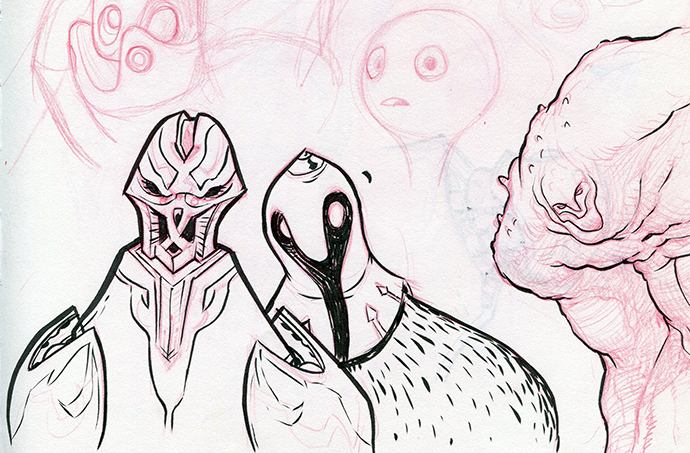How to Make a Good Drawing Great
If you’re anything like me, you decided to become an artist because you picked up a comic, or watched a movie, or saw an album cover that knocked your socks off. It spoke so profoundly to you and touched you so deeply, that you had no choice but to dedicate your life to understanding how to harness that same power.
So now, here you are. Hustling. Trying to make art that will move someone else as deeply as you were moved. You know what great art feels like, but you’re not sure how to get there.
Part of the challenge is perfecting your craft. Hopefully you’re already working dutifully on that. The other challenge is understanding how to produce and refine good ideas.
There are 3 essential steps to make that happen. First, you have to start with:
1. Research
Follow the example of Claire Hummel. Her work kicks ass, and guess what? She's a research berzerker. Just check out this post on Edwardian undergarments or her resources on historical costuming.
Just as your body needs good food to be strong and healthy, you mind needs a constant diet of good ideas to be creative.
This might be formal visual research to fill up your visual catalog, or it might be reading comics you love, or collecting images that inspire you on Pinterest (see if you can keep up with Jake Parker.)
Whatever it is, you should be constantly consuming good art, studying it and understanding it inside and out.
2. Play
Now that your artistic belly is full, it's time to start burning some creative calories - it's time to start cranking out ideas.
This is a time to be uninhibited, to have fun and to experiment. Your subconscious should be doing the heavy lifting here so do this in a context where you can be relaxed and playful. Don't think to hard about it and experiment with ways to get to that place in your mind where brilliant ideas seem to come out of nowhere. (Check out Jonah Lehrer's Imagine and Stuart Brown's Play for some ideas on how to do this.)
In this step your are a creative machine gun, firing out ideas indiscriminately with little concern about where they hit. You want to produce volume and novelty. We'll narrow things down later.
I have a quote by Henry Miller from his personal work commandments scrawled out on my drawing table:
“Work calmly, joyously, recklessly on whatever is in hand."
Relax, take a breath and remember that being creative is a joy. Dive in with abandon and don't look back.
3. Edit
One of the great insights from Lehrer's Imagine is that good ideas need to be refined to become great.
The best artists I've worked with understand this. A good idea and some artistic skill is a fantastic starting point, but to really hit the ball out the park takes a high standard of quality and good old fashion trial and error.
Compare yourself to the best artists. I think of the artists I admire the most and ask: "would this impress them?" If not, then work until you feel it would. Even better, see if you can get your art in front of them and actually impress them! There's no better way to test yourself.
Along those lines, surround yourself with artists that are far better than you and harass them for feedback. I'm fortunate enough to be working at Avalanche where I'm constantly challenged by the skill of the artists around me (seriously, that place is like Sparta for artists). When I'm wise enough to get other artists there to critique me, my work suddenly gets much, much better.
Don't Stop At Great
This is part of the editing step, but it's important enough that it deserves it's own callout.
When you finally get to the point of creating a design that really excites you, don't stop! This means that you've just made it to the threshold of the land of awesomeness, and now you just need to walk through the gate.
The odd thing about the editing step is that sometimes it's what's necessary to prime your subconscious and release the brilliance that's hiding inside.
So when you get to design that you really like, keep going. Your first good design just means you are warmed up. You will probably create better designs if you keep going. You just never know until you try pushing yourself further.
Here's a little design I was working on the other day as an example:
The thing is, there is still a lot of refining I could do on the final design, but the idea is to demand more from yourself, and push yourself past "good enough".
Lastly, remember the old adage from Thomas Edison: "Genius is 1% inspiration and 99% perspiration." Don't be fooled, all artists work hard to make great art.
Be persistent, set your standards high, and make some amazing art.


